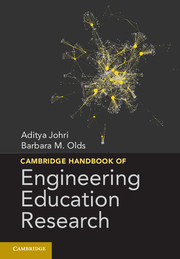Book contents
- Frontmatter
- Dedication
- Contents
- Editors
- Contributors
- Foreword
- Acknowledgments
- Introduction
- Chapter 1 Chronological and Ontological Development of Engineering Education as a Field of Scientific Inquiry
- Part 1 Engineering Thinking and Knowing
- Part 2 Engineering Learning Mechanisms and Approaches
- Part 3 Pathways into Diversity and Inclusiveness
- Part 4 Engineering Education and Institutional Practices
- Part 5 Research Methods and Assessment
- Part 6 Cross-Cutting Issues and Perspectives
- Chapter 30 Engineering Communication
- Chapter 31 Use of Information Technology in Engineering Education
- Chapter 32 Global and International Issues in Engineering Education
- Chapter 33 Engineering Ethics
- Chapter 34 The Normative Contents of Engineering Formation
- Chapter 35 Interdisciplinarity in Engineering Research and Learning
- Conclusion Engineering at the Crossroads
- Index
- References
Chapter 33 - Engineering Ethics
Published online by Cambridge University Press: 05 February 2015
- Frontmatter
- Dedication
- Contents
- Editors
- Contributors
- Foreword
- Acknowledgments
- Introduction
- Chapter 1 Chronological and Ontological Development of Engineering Education as a Field of Scientific Inquiry
- Part 1 Engineering Thinking and Knowing
- Part 2 Engineering Learning Mechanisms and Approaches
- Part 3 Pathways into Diversity and Inclusiveness
- Part 4 Engineering Education and Institutional Practices
- Part 5 Research Methods and Assessment
- Part 6 Cross-Cutting Issues and Perspectives
- Chapter 30 Engineering Communication
- Chapter 31 Use of Information Technology in Engineering Education
- Chapter 32 Global and International Issues in Engineering Education
- Chapter 33 Engineering Ethics
- Chapter 34 The Normative Contents of Engineering Formation
- Chapter 35 Interdisciplinarity in Engineering Research and Learning
- Conclusion Engineering at the Crossroads
- Index
- References
Summary
Introduction
Instruction and research related to engineering ethics is by no means a new field of practice. However, as the field of engineering education has been formalized and seen significant growth, the field of engineering ethics has naturally benefited. This chapter is divided into four subsections. The first section is a relatively brief overview of what engineering ethics is and how is it defined. The second section is a review of the historical development of engineering ethics in professional practice and in higher education. The third section is focused entirely on engineering ethics in education and addresses issues of curriculum content, pedagogical methods, resources, and instructor qualifications, as well as providing an overview of assessment of moral development. Finally, the fourth section focuses on engineering ethics in practice and covers such topics as the environment and sustainability, research ethics, application of ethics in international context, academic dishonesty, macroethics, and other emerging issues.
What Is Engineering Ethics?
Two of the most popular textbooks in engineering ethics define engineering ethics in similar yet different ways. The definition offered by Martin and Schinzinger (1996) in their classic text is descriptive:
Engineering ethics is (1) the study of moral issues and decisions confronting individuals and organizations engaged in engineering and (2) the study of related questions about the moral ideals, character, policies and relationships of people and corporations involved in technological activity.
(pp. 2–3)- Type
- Chapter
- Information
- Cambridge Handbook of Engineering Education Research , pp. 673 - 692Publisher: Cambridge University PressPrint publication year: 2014
References
- 24
- Cited by

